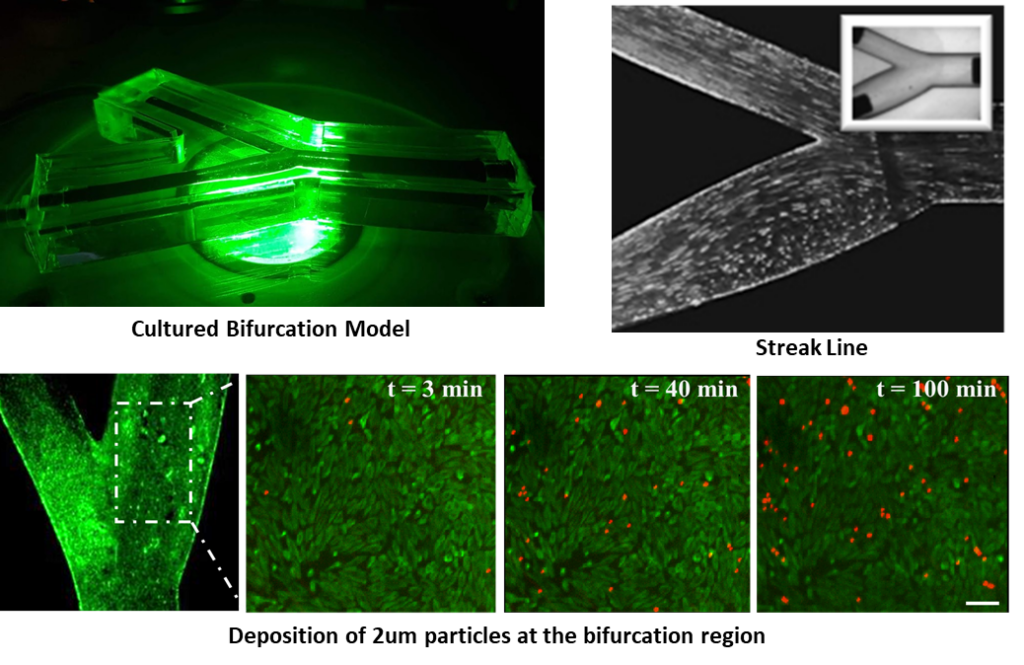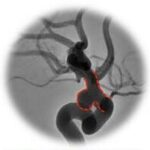Vascular targeting is a multistep process, which is based on the transport of drug carriers to the target region followed by deposition of drug carriers at the desired destination. Atherosclerotic lesions localize at specific regions in the blood vessel, such as: tight curves and bifurcations, where a recirculation flow occurs and thus targeting drug carriers may be affected by the abnormal flow patterns at these sites. Moreover, important flow parameters including Reynolds number and flow characteristics differ significantly at artery bifurcations, and are highly dependent on vessel geometry and blood flow pattern.
The goal of our research is to understand particle dynamics, deposition and adhesion in models of arterial bifurcations under physiological conditions. Therefore, we design and fabricate 3D artery models cultured with human endothelial cells, which are used for particle targeting experiments. Our findings highlight the fact that vessel geometry, particle adhesion properties, blood flow and the associated local hemodynamics, play a dominant role in particle localization. This research emphasizes the importance of using accurate physiological conditions when studying deposition of particles within the cardiovascular system. The presented approach may serve as a valuable tool to study targeted delivery of drugs and imaging agents for a wide range of cardiovascular diseases under patient-specific conditions.
Maria Khoury, PhD
 Cerebral side aneurysms are blood filled lesions commonly found in and around artery bends and bifurcations which may burst resulting in a hemorrhaging stroke. Rupture prone aneurysms are characterized by both ultra-low wall shear stress and ongoing inflammations resulting in disrupted endothelium with exposed collagen In My work we leverage the tendency of particulate matter to accumulate inside the aneurysm cavity coupled with the ability of platelets to adhere to exposed collagen via glycoprotein VI (GPVI).
Cerebral side aneurysms are blood filled lesions commonly found in and around artery bends and bifurcations which may burst resulting in a hemorrhaging stroke. Rupture prone aneurysms are characterized by both ultra-low wall shear stress and ongoing inflammations resulting in disrupted endothelium with exposed collagen In My work we leverage the tendency of particulate matter to accumulate inside the aneurysm cavity coupled with the ability of platelets to adhere to exposed collagen via glycoprotein VI (GPVI).
Mark Epshtein, PhD
Cardiovascular diseases are a major cause of morbidities and mortalities globally. Atherosclerosis is a chronic inflammatory blood vessel disease, characterized by the deposition of atheromatous plaques in the inner layers of arteries. As a result of plaque buildup on the vessel wall, atherosclerotic sites are characterized by lumen narrowing. Correspondingly, the hemodynamic conditions are considerably different from normal conditions. In our study, we aim to fabricate functionalized nanoparticles that aim to preferentially adhere at atherothrombotic sites. Furthermore, our study investigates particle’s deposition under real hemodynamic conditions and real-sized coronary artery geometries. In the future, functionalized drug carriers loaded with potent anti-thrombotic or anti-platelet drugs may be examined as a therapeutic vehicle that can locally inhibit thrombosis.
Yathreb Asaad, PhD candidate

Vasospasm, persistent contraction of the smooth muscle cells, is a common complication of subarachnoid hemorrhage (SAH). Blood in the subarachnoid space causes structural and biochemical changes leading to vasospasm, to prevent excess bleeding. It is characterized with inflammatory environment and with high shear stress. Current treatments are focusing on muscle relaxation drugs. They are given systematically, increasing the risk for severe side-effects. Nanomedicine may offer new treatment approaches for vascular diseases and may provide vascular site-selective drug delivery and controlled release. Our goal is utilizing the combined effect of endothelial cell dysfunction with disturbed flow caused by vasospasm, to design nanoparticles (NPs) with selective targeting to vasospasm regions, integrating vasodilatory drug. We plan to engineer real size model of human arteriole with hemodynamic that characterize vasospasm. Our research may offer provide a new potential medical approach for vasospasm. The approach of coupling both a targeting moiety and a vasodilatory drug to act simultaneously may offer improved outcomes.
Danielle Nemcovsky Amar, PhD candidate
